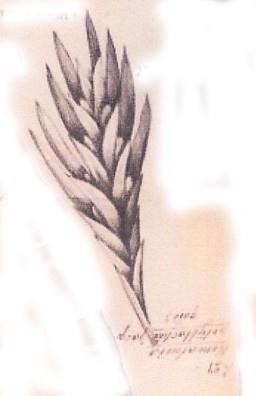
First I show the detail from S&D as synonyms of T. fasciculata var fasciculata.
Renealmia polystachia sensu Jacquin, Sel. Stirp. Am. 93, pl. 183, fig. 27. 1763; non Linnaeus, 1753. Based on Jacquin s n obtained in Habana, Cuba, and cultivated in Vienna. Not seen, identity fide Mez.
Platystachys havanensis Beer, Bromel, 85. 1857; nomen novum for Tillandsia polystachia sensu Jacquin.
Tillandsia havanensis Jacquin ex Beer, Bromel. 85. 1857; nomen.
This all started out in Feb 2009 when I was checking out the synonyms of Tillandsia fasciculata var fasciculata and was looking at Platystachys havanensis and Tillandsia havanensis in Smith & Downs. I also saw that these same species had been treated by Mez in 1935 as synonyms of T. fasciculata var venosispica. No reasons were given for this move which made me somewhat intrigued. Did Smith know something that Mez did not? These names had been published by Beer in 1857 and I knew that my friend Leo Dijkgraaf in Belgium had access to such material. He did not disappoint me, and here I was busily translating botanical German as written in 1857. Beer had used the name havanensis because this plant was based on Renealmia polystachia sensu Jacquin 1763 which was different to the T. polystachia of Linnaeus.
Now to the next phase of investigation. Where would a publication made in 1763 be?
Did you know that for some years now the Missouri Botanic Gardens have been digitally copying OLD Botanical publications and making them available on Botanicus.org This is a fantastic resource for someone with an archivist type brain. I found out that “Nicolae Josephi Jacquin Selectarum Stirpium Americanum historia. Publication info; Vindobonae: Ex officina Krausiana, 1763" was available! It was in 1763 Botanical Latin so Stearn’s 2004 Botanical Latin was only of limited assistance. To save you the job of translating, the following is my translation.
Renealmia (polystachia) scape with imbricate spikes, lateral. LINN. sp.pl. 2. p.286?
CALYX. Perianth monophyllous, flat sided, then convex, persistent. Tube very short, born around the receptacle. Blades erect, very long, converging, bifid: outside lacinia lanceolate-oblong, canaliculate-concave, acuminate; inside oblong, acuminate, posterior converging on the side canaliculate, anterior flat, bifid above.
COROLLA Petals 3, linear, canaliculate-concave, acute, erect, sides folded inwards one after the other, almost twice as long as the calyx.
STAMENS Filaments 6, filiform, erect, inserted in the receptacle, exceeding the corolla. Anthers oblong, obtuse, folded inwards.
PISTIL Ovary ovate, scarcely three angled, changing suddenly into a filiform style, situated and alongside the stamens. Stigma 3, subrotund, spreading.
PER. . .
SEM . . .
Plant parasitic growing on rocks shrubby & growing on trees. Stem is foliate, erect, 3 feet long. Leaves linear-subulate, acuminate, entire, canaliculate, base wide & swollen, numerous, lower ones 2 feet long. Spikes lateral, about 10, 1 foot long, red, alternate in the stem. Primary bracts red, imbricate above, covering the spikes totally. Flowers sessile, solitary, not scented, corolla blue. Fruit not seen.
Habitat: Havana growing on rocks and elsewhere. Found flowering in January.
From this genus or the preceding one, another species was also found near Havana as a maritime bony shrub growing as a parasite on rocks, whose flowers were unknown. Leaves linear-subulate, entire, imbricate, with similar leaf habit of Tillandsia tenuifolia, not at all maculate, and not spiralling. Stem divided into compressed spikes, whose alternate parts are about five, flat compressed, distichous, erect, with three or four capsules on both sides suberect & alternately imbricate. Drawing of the spike part is shown in figure 27. table CLXXXIII.
As you will see there was a drawing.
I was in contact with Eric Gouda and pointed out I felt the plant was closer to T. balbisiana because of the description of the leaves and the spike description. Eric advised his thoughts to Lucia Schwesinger who is doing a thesis on Tillandsia fasciculata. Lucia commented that these days around Havana you find T. utriculata, T. balbisiana, T. recurvata, and T. flexuosa, but no T. fasciculata.
I do not know what will be the final outcome but I feel confident it will not be considered as a synonym of T. fasciculata.
